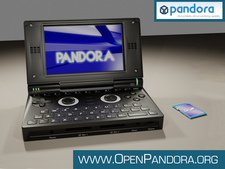Linux Pandora Box Goes into Mass Production
Around $330 gets you a Linux-based Pandora handheld by shopping online, although the first buyers had to hurry.
The Pandora looks like a Nintendo DS with a built-in keypad. It is the successor to the GP2X released around three years ago. The manufacturer, OpenPandora, hopes to produce 3,000 devices during this year -- assuming enough paid orders come in. Mass production should start 2009.
Visitors started besieging the OpenPandora website soon after the announcement and within six hours 2,000 orders had come in, bringing down the site for a short while. The forum was so overloaded that a temporary one had to be put in its place. The first batch of devices was orderable until Sunday, October 5 (even if they have to raise the batch to 4,000 units), and the first Pandoras should be entering the mail by end of November if all goes according to plan. The website will be updated on Tuesday with the final sales figures and the week after the very first of the mass production PCBs should be seen. The second batch orderable after October 5 should be available next year.
The diminutive Pandora handheld comes with an ARM Cortex-A8 CPU, 128MB active and 156 flash storage, and an OpenGL 2.0 ES-compliant PowerVR SGX 3D graphics processor. The 4.3" touchscreen LCD displays 800x480 pixels in 16 million colors. Input devices include the tiny gaming controls reminiscent of Gamepads and a 43-button QWERTY keyboard. Little treats include Wifi 802.11b/g, Bluetooth, a USB 2.0 port and an S-Video connection for TV output. The batteries should provide at least 10 hours of gaming pleasure. To see the Pandora in action, see the video on OpenPandora's Developer Blog page.
While all the possible tools for gamemakers are available for free on the developer wiki, older console emulators will probably keep the game supply coming, much as they did for the GP2X predecessor.
Subscribe to our Linux Newsletters
Find Linux and Open Source Jobs
Subscribe to our ADMIN Newsletters
Support Our Work
Linux Magazine content is made possible with support from readers like you. Please consider contributing when you’ve found an article to be beneficial.

News
-
Another Linux Malware Discovered
Russian hackers use Hyper-V to hide malware within Linux virtual machines.
-
TUXEDO Computers Announces a New InfinityBook
TUXEDO Computers is at it again with a new InfinityBook that will meet your professional and gaming needs.
-
SUSE Dives into the Agentic AI Pool
SUSE becomes the first open source company to adopt agentic AI with SUSE Enterprise Linux 16.
-
Linux Now Runs Most Windows Games
The latest data shows that nearly 90 percent of Windows games can be played on Linux.
-
Fedora 43 Has Finally Landed
The Fedora Linux developers have announced their latest release, Fedora 43.
-
KDE Unleashes Plasma 6.5
The Plasma 6.5 desktop environment is now available with new features, improvements, and the usual bug fixes.
-
Xubuntu Site Possibly Hacked
It appears that the Xubuntu site was hacked and briefly served up a malicious ZIP file from its download page.
-
LMDE 7 Now Available
Linux Mint Debian Edition, version 7, has been officially released and is based on upstream Debian.
-
Linux Kernel 6.16 Reaches EOL
Linux kernel 6.16 has reached its end of life, which means you'll need to upgrade to the next stable release, Linux kernel 6.17.
-
Amazon Ditches Android for a Linux-Based OS
Amazon has migrated from Android to the Linux-based Vega OS for its Fire TV.

